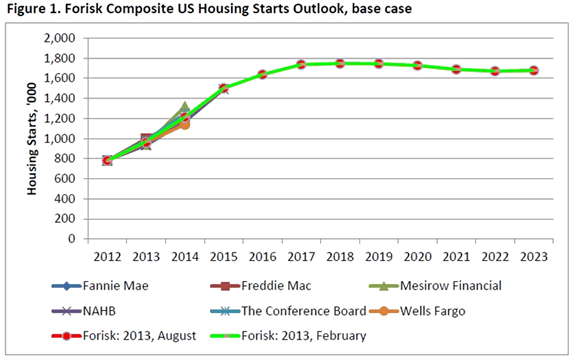In 1818, the great French mathematician and astronomer Pierre-Simon Laplace said:
“In combining the results of these…methods, one can obtain a result whose probability law of error will be more rapidly decreasing.”
In other words (and assuming no translation error from French), combining the results of multiple estimates or models can improve the accuracy of forecasts. This observation is consistent with the study and findings of forecast techniques over the past 50 years. The literature on combining forecasts informs Forisk’s approach to incorporating macroeconomic assumptions – such as housing starts – into forecasts of timber prices in the United States.
[For reference, Laplace was a scientific stud. His name is one of only 72 engraved on the Eiffel Tower.]
Housing Starts Outlook
Forisk’s Housing Starts Outlook combines publicly-available, independent forecasts from professionals in the housing industry. As of August 2013, these include Fannie Mae, Freddie Mac, Mesirow Financial, the National Association of Home Builders (NAHB), The Conference Board, and Wells Fargo, as well as long-term assumptions from the Energy Information Administration’s (EIA) model of the US economy (Figure 1).

Year-to-date, our expectation for 2013 housing starts in the U.S. has slowed a tick, with projected totals for 2013 dropping 0.9% from 970,000 to 961,000. Our 2013 Mid-Year (August) Base Case peaks at 1.747 million housing starts in 2018. For comparison, our February 2013 Base Case peaked at 1.749 million housing starts in 2018. So long-term, the trajectory and peak outlook has held firm. Housing starts continue to increase over the next four years before leveling out.
Implications for Timberland Investors
Housing starts, which critically affect forecasts of timber prices, continue to increase in the United States. This is good. Increased home building grows demand for lumber and other building products, which ultimately increase prices for wood raw materials such as pulpwood and sawtimber. However, investment trends in housing markets deserve attention and should not be taken for granted. For example, the move towards owning homes to rent rather than live in limits the “spillover” of spending into cabinets, furniture and hardwood floors. Those who buy homes as investments, or to “flip”, spend less on appliances and other improvements. In sum, the outlook on housing indicates increased demand for wood, but the impact on stumpage prices and timberland investments may lag, in part, because the nature and volume of this wood demand for homes varies from historic patterns.
This content may not be used or reproduced in any manner whatsoever, in part or in whole, without written permission of LANDTHINK. Use of this content without permission is a violation of federal copyright law. The articles, posts, comments, opinions and information provided by LANDTHINK are for informational and research purposes only and DOES NOT substitute or coincide with the advice of an attorney, accountant, real estate broker or any other licensed real estate professional. LANDTHINK strongly advises visitors and readers to seek their own professional guidance and advice related to buying, investing in or selling real estate.









Add Comment